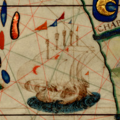Stampa:Javanese or Sundanese jong in China Sea, from Miller Atlas of 1519.png
Javanese_or_Sundanese_jong_in_China_Sea,_from_Miller_Atlas_of_1519.png (266 × 432 pixel, dimensjoni: 284 KB, tip ta' MIME: image/png)
Kronoloġija tal-fajl
Agħfas fuq il-grupp data/ħin biex tara l-fajl biex tara kif jidher dak il-ħin.
| Data/Ħin | Minjatura | Qisien | Utent | Kumment | |
|---|---|---|---|---|---|
| kurrenti | 07:15, 3 Novembru 2019 |  | 266 × 432 (284 KB) | Verosaurus | {{Information |description ={{en|1=Cropped portion of China Sea, showing 2 large ships, one is six-masted and the other one, being shown from the aft, showing 3 masted ship (there could be more since the sails obstructed the front masts). Since it's showed inaccuracies with the description of Malay junk of the time, the image is clearly an attempt to depict a large Malay junk.}} |date =1519 |source =Lopo Homem-Reineis Atlas or Miller Atlas |author =Lopo Homem, Pedro... |
Użu tal-fajl
Il-Paġna segwenti twassal għal din l-istampa:
L-użu globali tal-fajl
Il-wikis segwenti jużaw dan il-fajl:
- Użu fuq en.wikipedia.org
- Użu fuq es.wikipedia.org
- Użu fuq fr.wikipedia.org
- Użu fuq id.wikipedia.org
- Użu fuq ms.wikipedia.org
- Użu fuq uk.wikipedia.org
- Użu fuq zh.wikipedia.org


